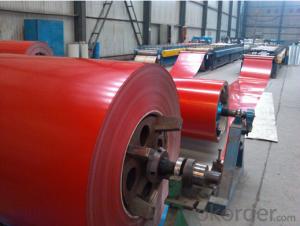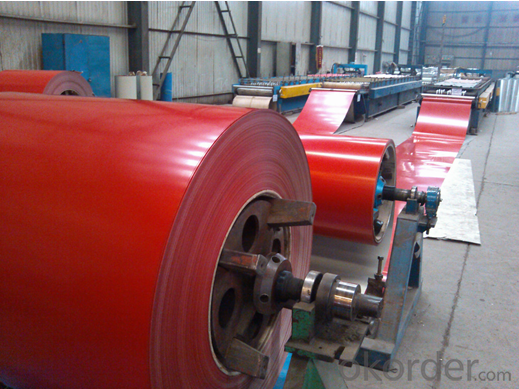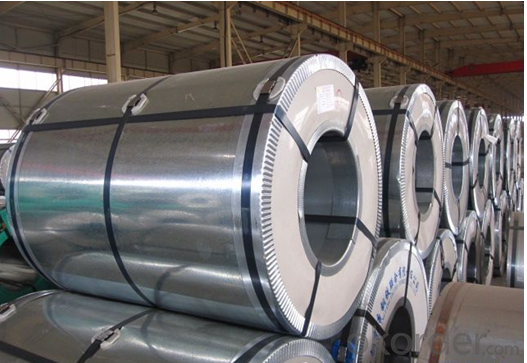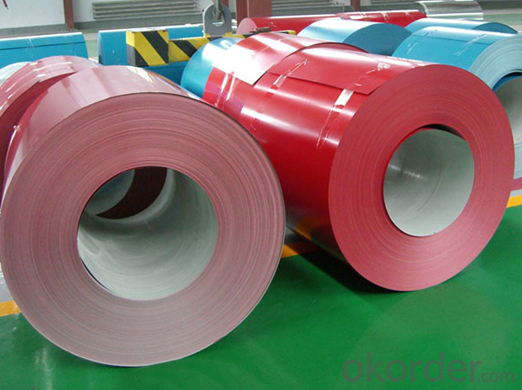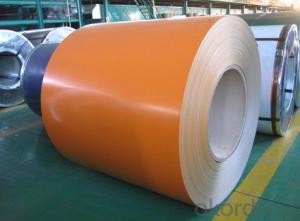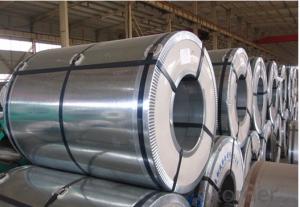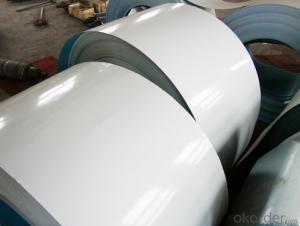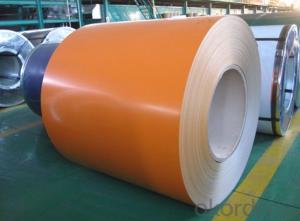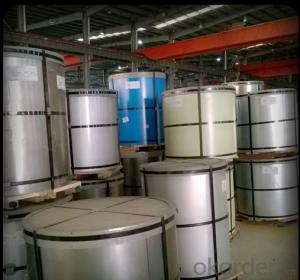Hot-Dip Galvanized Steel/Pre-Painted Steel Coil for Tiles Width 900mm-1250mm
- Loading Port:
- China main port
- Payment Terms:
- TT OR LC
- Min Order Qty:
- 50 m.t.
- Supply Capability:
- 1000000 m.t./month
OKorder Service Pledge
OKorder Financial Service
You Might Also Like
Product Description Prepainted galvanized steel coil, PPGI, PPGL, Prepainted galvalume/aluzincsteel, Color Coated Galvalume Steel Coil, Prepainted Galvalume Steel Coils, RAL color, 0.15-1.5mm, SGCC, CGCC, CGLC, DX51D, TDC51D, ASTM A653, CS TYPE, S280GO, S350GD, G550, JIS G3312, EN 10169 JIS G3322, ASTM A755/755M, comercial and structual quality commodity Brick pattern Color Galvanized Steel Sheet (PPGI/ PPGL) Techinical Standard: JIS G3312-1998, EN101169, ASTM A755 grade TSGCC, TDX51D / TDX52D / TS250, 280GD Types: For general / drawing use Base metal galvanized, galvalume Thickness 0.14-3.0mm(0.16-0.8mm is the most advantage thickness) Width 610/724/820/914/1000/1200/1219/1220/1250mm Type of coating: PE, SMP, PVDF Zinc coating Z60-275g/m2 or AZ40-150g/m2 Top painting: 5 mic. Primer + 15 mc. R. M. P. Back painting: 5-7 mic. EP Color: According to RAL standard ID coil 508mm / 610mm Coil weight: 4--8MT Package: Properly packed for ocean freight exportation in 20' ' containers Application: Industrial panels, roofing and siding for painting / automobile Price terms FOB, CFR, CIF Payment terms 20%TT in advance+80% TT or irrevocable 80%L/C at sight delivery time 25 days after recepit of 20% TT Remarks Insurance is all risks MTC 3.1 will be handed on with shipping documents We accept SGS certificatation test PPGI,(PPGL,pre-painted galvanized steel coils, pre-painted galvalume steel coils,color coated steel coils.color coated galvanized steel coils)
Specifications of Pre Painted Galvanized Steel Coil:
1) Capacity: More than 20, 000 tons per month for PPGI coil product manufacture
2) Standard: JIS G3302, JIS G3312, ASTM A653M/A924M 1998
3) Grade: SGCC CGCC, DX51D, TDC51D, ASTM A653 CS TYPE, S280GD, S350GD, G550
4) Thickness: 0.15mm-1.5mm
5) Zinc coating weight: Z60-275G/M2, G30-G90
Zinc coating: Z60, Z80, Z100, Z120, Z180, Z275, G30, G60, G90
Alu-zinc coating: AZ60, AZ80, AZ100, AZ120, AZ180, G30, G60, G90
6) Width: 600mm-1250mm, 914mm, 1000mm, 1200mm, 1219mm, 1220mm, 1250mm or according to the customer's request
7) Coil ID: 508mm-610mm
8) Coil Weight: 3-6mt, or according to the customer's request
9) Color: RAL, or customer sample color
RAL9016, RAL9002, RAL5015, RAL5002, RAL3000, RAL3020, RAL3009, RAL6005, RAL8017 etc.
10) Color coating type: PE, PVDF, SMP, HDP, etc.
Regular Polyester, Silicon Modified Polyester, Polyvinylidene Floride, PVDF, Super Low Gloss Polyester
11) Surface protection: PVC film protected according to customer requested
12) Min trial order: 25 tons for 1X20' per delivery
PPGI Manufacture
ThicknessWidth LengthColor Coating type
0.2mm-1.5mm600mm-1250mmAs your requestRALPE, PVDF, SMP, HDP, etc.
Coating Chief Feature
ItemThicknessTypeFeature
Laminated film50μ MPolyethyleneProtecting from scratchs and contamination
(option)
Top coat20μ MPolyester FluorineChemical resistance and formability
Primer coat5μ MPolyesterWorkability, corrosion resistance and adhesion to the primer coating
Chemical treatment1μ MChromateGood adhesion and corrosion resistance
Substrate0.2mm-1.2mmGI. GL, ALGI. GL, AL
Back coat5± 2μ MEpoxyCorrosion resistance and adhesion to the substrate
Characteristics:
20 years outdoor liability approved, Corrosion protection, Long life-time for coated color
APPLICATION:
Exterior decoration of buildings: Roof and wallboards of industrial, commercial, residential and public facilities
Interior decoration of buildings: Wallboards, ceiling boards, partition boards, fireproof doors
Building accessories: Window panels, signboards
Home appliances: Oil/gas boilers, rice buckets, portable gas burners, etc.
1, Introduction: PPGI is made of galvanized steel coils or galvalume steel coils with polymer coatings as surface. It's a new enclosure material and building board
2, Product feature: Apperance of a variety of color Antirust and antiseptic,durability,etc.
3, Production Process: Pretreatment(Degreasing) DryingChromatingPaint Basic OilCoolingDryingColor CoatingCoolingFilm- coveringRolling Up
4, Application: it is ideal for a wide range of applications,, such as pre-engineered buildings, architectural panels, roofing, siding, cladding, and many other building components.and also used back plate of appliance; wide range of construction, furniture industry, transportation industry, etc.
FAQ
1.Do you have QC teams?
Yeah, sure, our QC team is very important, they will keep the quality control for our products.
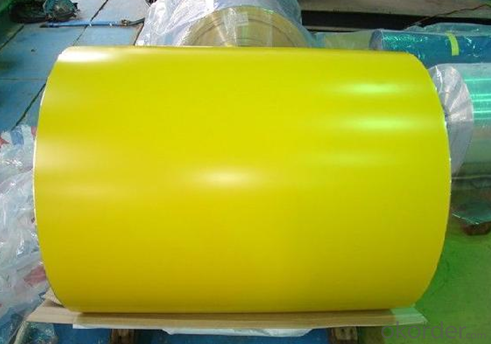
- Q: I just bought a used Taurus 85 stainless 38 spl revolver, it's about 25 years old but looks like new. This is my first stainless steel gun. I'm wondering if there's any special things I need to be aware of or cleaning methods? I'm also wondering if stainless steel could rust? in theory stainless means it cannot get stained or rusty. I have a chrome bore AK, cleaning is always super easy, wondering of cleaning a SS revolver would be the same.
- Stainless steel WILL rust, but it takes longer. Just think of Stainless as stain less - less, but still present. Clean it as you would any other blued firearm. Keep the same coating of protective oil or preservative lubrican on it as you would a blued gun, and it will look shiny pretty much forever. Stainless steel is not rustproof...it is merely MUCH more forgiving of a harsh world than blued steel. Stainless is not the same as hard chrome. Stainless is STILL steel...so you may have to brush it in places a lot to get the crud out, especially after those thousand-round marathon shooting sessions. But the results are pretty impressive, as you will soon see. Happy shooting!
- Q: The guy at this one pawn shop told me that stainless steel is better because it is just as strong and will not rust. The guy at the other pawn shop said that you need high carbon steel for a good sword because stainless steel breaks easily and that damascis is the best kind of steel for swords.
- Modern Sword Steels: Stainless - Used in decorative swords and knives. Stainless steel blades longer than twelve inches are too brittle for full contact use. 1045 Carbon - Strong, but soft compared to higher carbon steels. Reasonably cheap and acceptable for full contact use. 1060 Carbon - Harder than 1045, but not brittle. Holds a keen edge and is very durable. Somewhat expensive, but great for full contact use. 1095 Carbon - Sacrifices the durability of lower carbon steels for better edge retention and increased hardness. Somewhat expensive, but tough enough for full contact use. 5160 Spring - Extremely tough and durable. Great for full contact use when properly heat treated. 9260 Spring - Amazingly resilient and durable, but not unbreakable. Excellent for full contact use. T10 Tool - Exceptionally hard and tougher than other steels with similar carbon content. Keeps a good edge without sacrificing durability. Can be expensive, but is still great for full contact use. L6 Bainite - Can be very expensive, but is the toughest steel on the market when properly heat treat. Excellent for full contact use, but requires additional maintenance to prevent rust and corrosion. About Damascus Steel: Historical Damascus blades were made from wootz, an Indian steel with unique properties. The technique for making this type of steel has been lost, but there have been many attempts to recreate it. The patterns found on Damascus steel blades are a direct result of the sword-making process and are not entirely dependent on the type of steel used. Damascus swords were the finest blades of their time.
- Q: How long can steel coils be stored before they need to be used?
- Steel coils can typically be stored for an extended period of time without any significant degradation. However, it is recommended to use them within 6 to 12 months to prevent any potential corrosion or damage.
- Q: How are steel coils used in the production of automotive wheels?
- Steel coils are used in the production of automotive wheels as they are shaped and molded into rims before being welded or bolted onto the wheel hubs. The steel coils provide the necessary strength and durability required for the wheels to handle the weight and stresses of the vehicle, ensuring a safe and reliable driving experience.
- Q: What are the challenges in coil slitting?
- Coil slitting is a process used to cut large coils of metal into narrower strips of desired widths. While it offers several advantages in terms of efficiency and flexibility, there are also several challenges associated with coil slitting. One of the main challenges in coil slitting is ensuring consistent strip width accuracy. Since coil slitting involves cutting the metal coil into smaller strips, it is crucial to maintain consistent width measurements throughout the process. Any deviation in the strip width can lead to issues downstream in the production line, affecting the quality and functionality of the final product. This challenge requires the use of precise slitting equipment and careful monitoring of the process parameters. Another challenge in coil slitting is managing edge quality. The edge quality of the slit strips is critical, especially in applications where the edges need to be free from burrs or other imperfections. Achieving clean and smooth edges requires proper blade selection, positioning, and maintenance. Any defects or irregularities on the strip edges can impact subsequent processes like bending, welding, or coating. Additionally, coil slitting poses challenges related to the material itself. Certain types of metals, such as high-strength steels or alloys, can be more difficult to slit due to their hardness or brittleness. Slitting these materials may result in blade wear and premature failure, leading to increased downtime and maintenance costs. Furthermore, the presence of contaminants or surface defects on the coil can also affect the slitting process, requiring additional cleaning or preparation steps. Another significant challenge in coil slitting is handling and processing large coils. Coils can be heavy and unwieldy, making it crucial to have proper equipment and procedures in place to handle them safely. Additionally, the slitting process can generate significant amounts of scrap material, which needs to be efficiently managed and disposed of. Proper storage, transportation, and recycling of the scrap are essential to minimize waste and maintain a clean and organized working environment. In conclusion, coil slitting offers numerous benefits in terms of customization and productivity. However, it also presents challenges in maintaining strip width accuracy, managing edge quality, dealing with difficult materials, and handling large coils and scrap. Overcoming these challenges requires expertise, precision equipment, and careful process control to ensure the desired quality and efficiency in coil slitting operations.
- Q: Maybe it is obvious. But i have thought alot about it.I thought steel at a cool temperature was unbreakable. I am not one for science or physics or engineering (i am a political science major). But i don't understand why the planes that struck the world trade center on 9-11 didn't just dent the side and fall,How did the place break the steel? Was it the velocity? Is steel easily broken?I realized that i wasn't taught how the planes broke the steel, and that no one ever asked. I searched the web and i couldn't find the answer or even anyone who had asked the question before.(i don't care about conspiracy theories, i just want scientific facts)
- steel is not unbreakable. the world trade centers had a steel infrstructure, but were mostly glass and materials with many other flaws. steel is not the top of the rocwell scale(materials rated by thier hardness) when the planes impacted the outside of the buildings, you have to take into account that the planes skins and infrastructure where made of aluminum(too keep weight down) so once the outer skin of the planes was breached, you have to account for the heat created by burning fuel, friction, and the momentum of a vehicle that weighs tons hitting an immovible object. just keep in mind that if you propel a piece of straw at an proper speed, you can have it impale a full grown palm tree
- Q: Correct me if I am wrong, but steel is an alloy between iron and carbon. Does the carbon in the steel stops the iron from rusting or corroding? Also what is the difference between mild steel and stainless steel?
- Mild steel is an alloy. It is the most common form of steel. Mild steel (a so-called carbon steel) is a general term for a range of low carbon (a maximum of about 0.3%) steels that have good strength and can be bent, worked or can be welded into an endless variety of shapes for uses from vehicles (like cars and ships) to building materials. The carbon does not stop the material rusting or corroding. In addition to iron, carbon, and chromium, modern stainless steel may also contain other elements, such as nickel, niobium, molybdenum, and titanium. Nickel, molybdenum, niobium, and chromium enhance the corrosion resistance of stainless steel. It is the addition of a minimum of 12% chromium to the steel that makes it resist rust, or stain 'less' than other types of steel. The chromium in the steel combines with oxygen in the atmosphere to form a thin, invisible layer of chrome-containing oxide, called the passive film. The sizes of chromium atoms and their oxides are similar, so they pack neatly together on the surface of the metal, forming a stable layer only a few atoms thick. If the metal is cut or scratched and the passive film is disrupted, more oxide will quickly form and recover the exposed surface, protecting it from oxidative corrosion.
- Q: Can steel coils be coated with aluminum?
- Yes, steel coils can be coated with aluminum. The process is known as the hot-dip method, where the steel is first cleaned and then dipped into a bath of molten aluminum. This results in a protective layer of aluminum coating on the steel surface, enhancing its corrosion resistance and providing aesthetic appeal.
- Q: What are the challenges in welding steel coils?
- Some challenges in welding steel coils include potential distortion due to heat, ensuring consistent and strong welds along the entire length, managing the high temperatures involved, and avoiding defects such as porosity or cracking. Additionally, the large size and weight of the coils can pose logistical challenges for handling and positioning during the welding process.
- Q: can u use stainless steel to make a coin? why or why not? answers based on facts plz.
- Stainless steel has been used by some countries to make coins, but it's not an ideal metal. When a coin is struck, a die comes down and strikes the blank with many tons of force (the blank is also sitting on top of another die--one has the image on the obverse (front) of the coin, while the other die has the image of the reverse of the coin). When the die strikes the blank, the force causes the metal in the blank to flow into the recesses of the die. The problem with stainless steel is that it doesn't want to flow into the die. To get an image, either the relief (how high the raised portion of the design will be) has to be very low, and the coin has to have a simple design, or they have to greatly increase the pressure of the strike. This slows the coining press down, and greatly shortens the life of the dies.
Send your message to us
Hot-Dip Galvanized Steel/Pre-Painted Steel Coil for Tiles Width 900mm-1250mm
- Loading Port:
- China main port
- Payment Terms:
- TT OR LC
- Min Order Qty:
- 50 m.t.
- Supply Capability:
- 1000000 m.t./month
OKorder Service Pledge
OKorder Financial Service
Similar products
Hot products
Hot Searches
Related keywords
